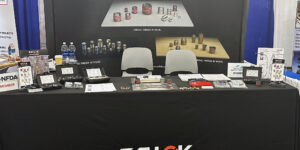INNOVATIVE SHOT PEENING SOLUTIONS FOR AIRCRAFT STRUCTURAL COMPONENTS
Aircraft components often require shot peening to strengthen the material, reduce surface variations and increase expectant life. Kumar Balan of Wheelabrator explores how they helped Skills Inc. develop an effective peening solution for the components they supply to Boeing.
Posted: August 1, 2009
Skills Inc. (Seattle, WA) specializes in aerospace-certified processes such as NDT, shot peening, and chemical processing for complex aluminum machined aerospace components such as inspar ribs, chords, stringers, etc. Their customer base includes all major aircraft manufacturers. With a 300 person workforce, they operate three highly productive plants in an environment that?s strictly regulated by OEM specifications and rigorous Nadcap audit criteria.
Conformance to specifications and regular third party audits are ongoing requirements. Although Skills Inc. had approvals for shot peening, they did not have the correct equipment to handle the size and volume of shot peening that was connected to a large opportunity presented to them by a local high speed machining company that had recently been awarded a long term contract for structural components used on a narrow body jet.
Expanding the shot peening capability and capacity at Skills Inc. was a strategic initiative because of the limited number of vendors that could provide processing of structural components up to twenty feet in length. For Skills Inc., pass-through automated shot peening was the missing link, so they approached Wheelabrator Group to assist them in developing an effective peening solution for aircraft structural components.
Some of the key application and solution considerations identified by Skills Inc. for this new purchase included:
? Preventing warpage of parts
? Equipment design for specification conformance
? Consistency and repeatability of peening results, and
? Peening process development and training
PEENING: A BRIEF BACKGROUND
Peening is a cold working process whereby the part being peened is impacted with metallic (and in some cases non-ferrous) media (steel shot or conditioned cut wire and glass bead or ceramic bead in case of non-ferrous media). Impingement of this peening media imparts a layer of compressive stress on the part that considerably delays the occurrence of fatigue failures such as cracking.
Peening is measured in terms of deflection of a strip of spring steel called the Almen Strip. Deflection of this strip is measured in thousands of an inch and is always dictated by the engineering specifications associated with the part being peened. This deflection is called ?Almen Intensity?.
Almen strips are calibrated in three thicknesses, the ?N? strip (0.031 in), ?A? strip (0.051 in) and ?C? strip (0.0938 in). Most commonly, the ?N? strip is used in peening with non-ferrous media. Aerospace peening applications with ferrous media such as steel shot and conditioned cut wire almost always employ the ?A? strip.
The type of strip, intensity requirement, coverage, peening media size and type are all specified by the designer of the component being peened. This is usually arrived at after extensive fatigue testing of the component and expectations of useful life.
ELEMENTS OF THE SOLUTION
Warpage
The intensity requirements for parts at Skills Inc. ranged from 0.004 in A to 0.11 in A. Warpage was a concern for thin gage parts and those with low intensity requirement.
The Wheelabrator® system solution incorporated blast nozzles on both sides of the part as it passed through the blast zone. A pressure type media propulsion system was chosen for this application over a suction/siphon style propulsion. This is due to the fact that pressure blast systems offer more control, regulation and monitoring of media velocity, critical to this application.
Also, blasting from both sides prevents potential warpage of thin-walled parts. The application of a uniform blast stream on both sides of the part ensures even coverage of all areas of the part without the creation of localized hot spots.
Blast nozzle orientation determines the spray pattern and therefore the area of impact on the actual part. After extensive tests at Wheelabrator, the nozzle arrangement that resulted in oval spray patterns on all four corners of a square target plate was determined to be optimum for the current application.
Specification Conformance
Machine design is an important part of specification conformance. Among other aspects, conformance to commonly used specifications requires monitoring and control of (a) air pressure, (b) media size, (c) part exposure and (d) media flow (quantity).
Though specifications do not stipulate a particular method of monitoring and controlling process variables, the following means are popularly adopted:
? PID loop for air pressure (a PID ? Proportional ? Integral ? Derivative controller attempts to correct the error between measured and set-point values)
? Vibratory classifier with different screen sizes (listed in most specifications for particular shot and conditioned cut wire sizes) for size classification
? Media flow control valve with regular drop tests for verification
? PLC-driven Operator interface with graphic display of the process
Consistency and Repeatability of Peening Results
Peening specifications are drafted with the principal purpose of achieving consistent and repeatable results. However, interpretation of these specifications could be subjective, leading to questionable results. Therefore, it is important to maintain a standard procedure for operation and testing that will be uniform regardless of the person running the process.
As a minimum, it is important to conduct the following tests to achieve consistency and repeatability of results:
(a) drop tests at regular intervals to measure and confirm that media flow from each blast nozzle remains within range. This should also be checked with the digital readout on the operator interface and correction factors applied when necessary,
(b) blast media should be screened for size consistency offline using a sieve shaker, at least once a shift,
(c) blast media should be checked for shape consistency at least once a shift, (d) Shut-down limits should be tested once a shift.
The above takes care of the process variables. It is also required to test the intensity and saturation on the almen strips either every shift or whenever a different part type is introduced in the machine for peening.
Peening Process Development and Training
Visually, a shot peening machine may appear to be no different from a blast cleaning machine. However, the intricacies of the process are clearly different as detailed in our earlier discussions. Some of the specific items that the operators were trained on included arriving at optimum travel speeds for different part styles, air pressure, media flow and inspection of intensity, saturation and coverage.
Also beneficial was the fact that this computer-controlled machine had graphic displays of all process variables in real-time. For example, an input/output screen displayed the status of all PLC inputs, making it simpler for the operator and maintenance personnel to narrow down the root cause of a machine fault.
SUMMARY
A combination of manpower and machinery sophistication led to a successful peening installation (followed by an identical repeat machine, due to increasing volumes) at Skills Inc. Most important, in the shot peening world, learning never stops, just as Wheelabrator and Skills Inc. found out at this installation.
– – – – – – – – – – – – – – – – – – – – – – – – – – – – – – – – – – – – – – – – –
Kumar Balan is the international sales manager for Wheelabrator Group, 1219 Corporate Drive, Burlington, Ontario L7L 5V5, Canada, 905-320-3824, Fax: 905-319-7561, www.wheelabratorgroup.com.









